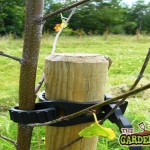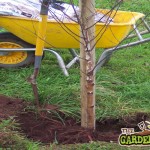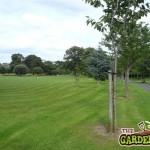A new season and more weather woos for the Irish gardener. The frost of course isn’t behind us but a new battle has begun in the garden. The move away from the cold winter days and the arrival of milder weather brings with it strong and sometimes gale force winds.
- Tree Stakes
- Tree Stakes
- Tree Stakes
Windy weather can cause severe damage to trees and taller shrubs and recently planted shrubs. If a tree stake has not been used to secure a tree or shrub properly it can lead to the tree swaying in the breeze which in turn leads to the plant rocking and swaying causing poor anchorage of roots in the soil. With poor anchorage the roots lose the ability to absorb water and nutrients.
Wind damage can also occur in the form branches falling off, trees becoming lopsided, and general damage to the plant. Wind can also increase water loss in younger plants making them more require better contact with the soil for increased water up take. Wind is also a carrier of pathogens such as rusts, botrytis and Phytophthora infestans or Potato Blight. Wind can also damage vegetables such as top heavy cauliflower, broccoli and cabbage.
To protect against wind damage tree stakes are required of secure trees and shrubs and prevent excessive rocking and swaying. To correctly stake a tree there are a number of steps that must be followed:
Choosing the right tree stake. The stake should be at least 1/3 the height of the tree. If you are planting a semi mature tree then you should consider using 2 or 3 stakes to sufficiently support the tree. Tree stakes come in a range of shapes, sizes and qualities. Younger trees (those with a stem girth of 10cm or below) would require a tree stake that is at least 1/3 its height and about 3 inch in diameter. Note: trees with a girth or diameter of 10cm are generally 7 to 9ft tall. Therefore the stake should be a minimum of 4 ft tall. The stakes should be treated and a softwood stake would be sufficient.
Staking a tree: It is important to stake the tree properly. To find out how; read my article on “how to Stake a Tree’
Other ways to control and protect against wind includes adding windbreaks, plant wind resistant trees and planning your garden around its own micro climate.
It is important to know your gardens micro climate; this is the climate within your own garden. Wind tunnels and exposed areas will be problem areas in your garden and you should plan around these areas.
If your garden is exposed to the winds you can install wind breaks. Windbreaks are lines of planting that filter and diffuse the wind, creating calm conditions. The size, number of rows and choice of planting for a wind break depends on the exposure of your site. For an open site in the countryside with little or no protection from prevailing winds two or three rows of planting would be required to sufficiently break the wind. The planting should be done in a way that a taller and larger line of trees are planted along the outer site boundary, followed by a lower row of medium height trees and finally a row of mixed planting shrubs at various heights of up to 6ft.
With a wind block on this scale the trees and foliage will diffuse and weaken the prevailing winds so that only a gentle breeze is felt within the site itself. This type of block is far more effective than concrete walls where the wind will simply hit and roll over it, leading to windy conditions beyond the wall. Of course a wind break on this scale would require a lot of space (roughly 12M).
Inside the garden itself further wind barriers can be added in the way of willow or reed screening or a mesh plastic wind breaker. These can be used around vegetable plots and along young hedge rows to protect them wind damage.


